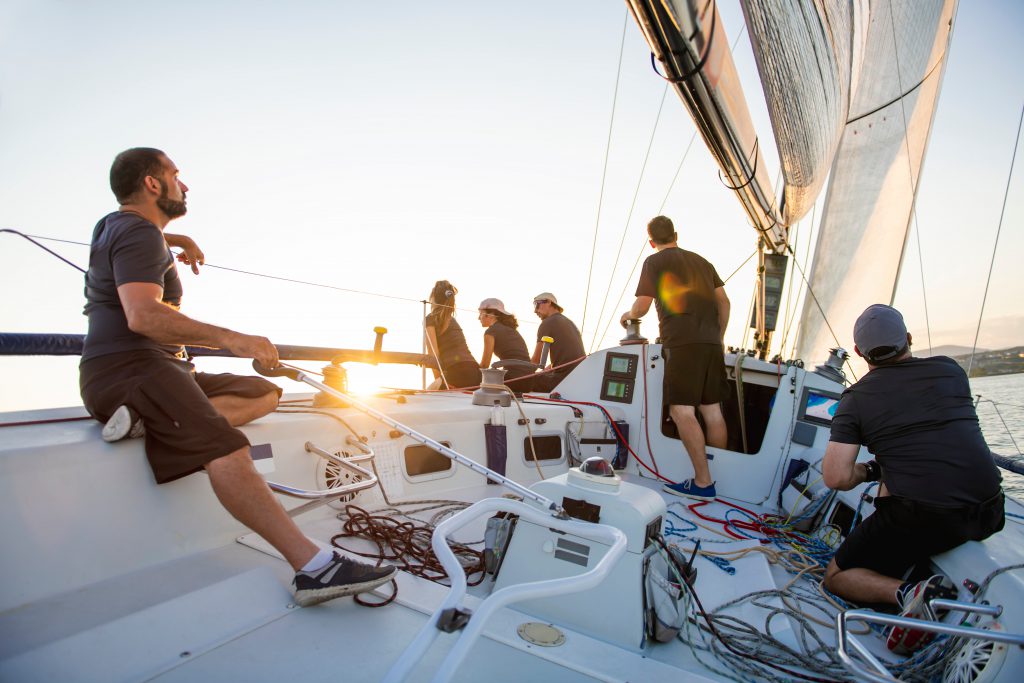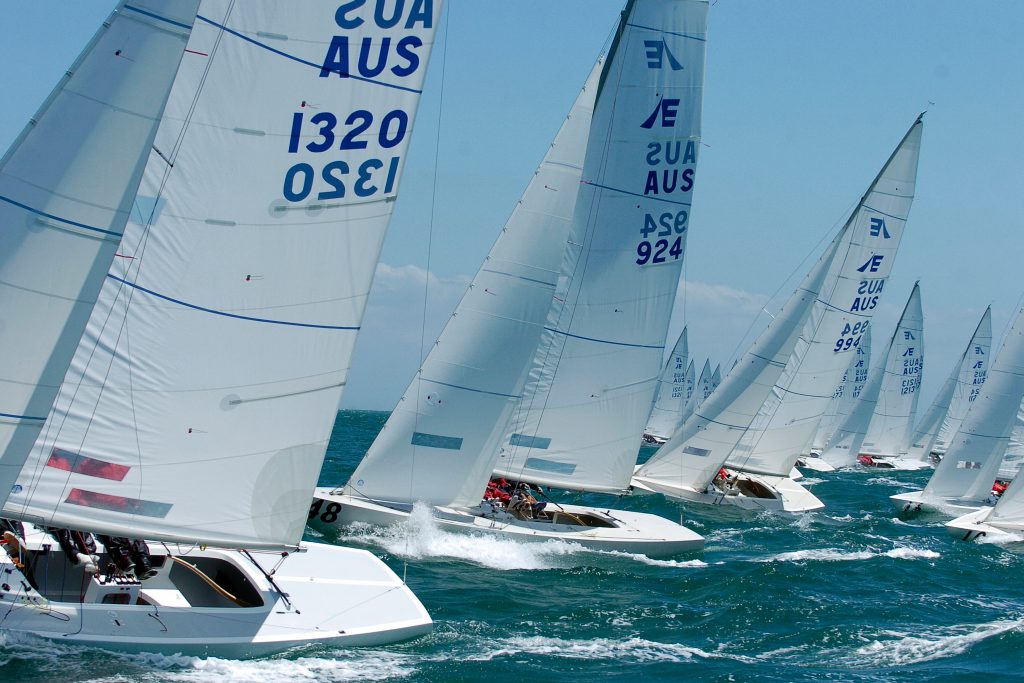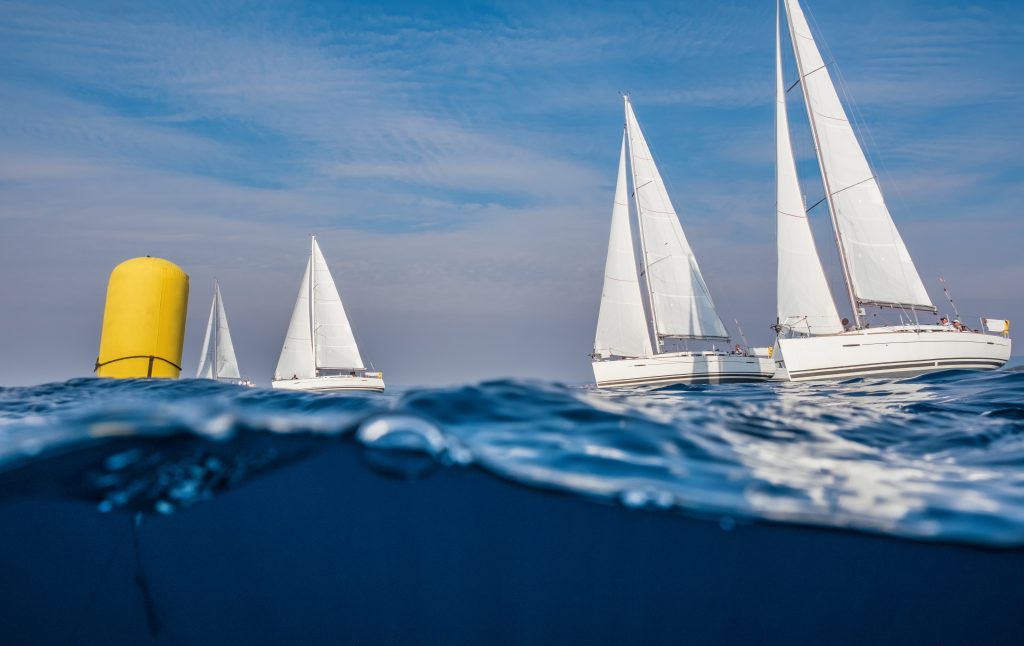Tips for New Racers, its Regatta Season
June 30th, 2022 by team

by B.J. Porter (Contributing Editor)
Racing your sailboat is not only fun, but it’s a great way to make new friends and sharpen your sailing skills. You’ll learn better helm skills, sail trim, reading the wind, minding currents, and a lot of other parts of sailing you may not pay as much attention to when you’re just out for a joy ride. With time, you’ll see a big difference in your comfort with your own boat and you’ll get a lot more out of her on those non-racing excursions.
But racing can be intimidating. Starts are chaotic, ratings and handicaps can confuse, and the whole thing can look like pandemonium until all the boats start and settle into the first upwind leg. But there’s a lot you can do to learn what’s going on and get you, your boat, and your crew ready to have fun and be competitive.
Learn the Rules

Most regattas require that every boat have a copy of the current Racing Rules of Sailing on board. But there’s no requirement that you read it…
Learning the rules is a critical piece of racing safety preparation, and a thorough understanding of the rules can give you a strong tactical advantage on the water. There are a lot of scenarios where you have rights for certain maneuvers and obligations to give way in others. Committing penalties is SLOW, since you’ll end up doing penalty turns or may even get disqualified from a race for ignoring rules.
So over the winter before you race, get the latest version of the Racing Rules of Sailing U.S. Sailing or your country’s governing body – any chandlery will have it, or you can order it online. Read it all the way through, though you can skip some sections if they aren’t relevant to you, like model boat racing rules. Then try a few online rules tests, or get a supplemental book with rules examples, questions and answers to help you study.
Practice, Practice, Practice

Finding crew when you’re new to racing can be tricky, especially if you’re not on a flash race boat in the fast fleet. But when you find people to sail with you, look for people willing to come out a few times and practice before the season starts or during the season.
Boat handling under pressure is harder, and in racing speed is everything. Sail changes, tacks, and jibes all need to be crisp, quiet, and efficient. This takes time working together. Even if you land a crew of expert sailors, getting them functioning as a smooth, well-oiled team takes time in the boat. Your results will be better if that training isn’t happening during a race that counts in the standings.
Things to practice with our crew include:
- Starting. Set up a practice start line with some floats or marks, set one crew to time keeper, and practice hitting that line at full speed when the timer hits zero.
- Tacking should be an automatic process that barely slows you down. There’s a lot of pieces to time, and everyone is doing something. Do quick tack drills – tacking the boat, getting up to speed, then tacking again…and again…and again. Ten quick tacks in a drill is tiring, but that tenth tack will be a lot smoother than the first.
- Mark roundings and sail changes are areas a lot of boats make mistakes and lose speed. They are complex and have to happen quickly. Drill both upwind and downwind roundings until you can do nice tight roundings with no mistakes.
- Different spinnaker sets and takedowns give you tactical options on the course. At a minimum, your crew should know how to do a standard bear away set and a jibe set in case the wind is on the other side of the course.
Clean the Bottom
You don’t need to go out and put a shiny racing bottom on your boat unless you’re committed to racing as the major part of your boat use. Soft ablative paints aren’t as good for racing performance, but there are some compromise paints that are hard enough to be smooth but still keep growth off.
But no matter your paint choice, a clean bottom is a must! If you have slime on your bottom, it will slow you down a little. If you have plants and hard growth on your bottom, there is little chance you can be competitive. So get the bottom cleaned before racing season and stay on top of the growth.
Watch Your (Boat’s) Weight

Moving a sailboat is basic physics. If you apply the same the same force to a two different masses, a lighter object will move faster. So do what you can to decrease your boat’s weight as much as possible. Serious racers spend serious money on super-light gear to shave even a couple of pounds, especially aloft in the rig. For club racing, you don’t need to get that crazy, but there are some things you can do to be more prepared.
- Empty your water tanks. Carry bottles for the crew during the race, but at 8 pounds to the gallon, even a small 30 gallon tank weighs as much as an extra large crew member.
- Go light on fuel. If you’re headed out with the family for a weekend, tank up. But if you’re racing later that week…don’t fuel up before race day. Fuel is heavy, too. If all you do is race, try to keep your tanks at a low but safe level – most racing sailors aim for about a quarter tank.
- Remove extraneous gear. It’s amazing how much stuff you’ll find on your boat if you empty it. Spare parts, cruising gear, and other bits you don’t use during a race all add up. If you race and cruise your boat, it’s a fine balance to strike, and it adds work.
Pre-game Preparation
Start watching the weather the day before your race. Monitor it and check detailed wind predictions. You can win a race by playing a predicted major wind shift, and having some idea what to expect as the race progresses will help you make better decisions.
Also check the tides and currents, and good current play can win a race, and sailing into the teeth of the current while everyone else dodges it will shoot you straight out the back of the fleet.
Make sure you’ve got snacks and drinks for the crew; water is best though some may prefer soft drinks. For full day regattas, you’ll need to have lunch. But watch how much you bring. It’s all heavy, so reasonable but generous quantities are your target. Sailing fast is hungry and thirsty work.
Some Things Not to Do

There are a lot of ways to enjoy racing, and a lot of ways to make it a misery. And there are much cheaper and easier ways to spend your time not having fun.
Don’t Yell
Yelling skippers get reputations and have a hard time finding crew because they are not fun to sail with. Voices need to be raised to hear over wind and boat noises, but take care of your tone, your volume, and your profanity. This applies whether you’re the skipper or the crew. I once uninvited a great sailor from my team because he was so obnoxious to everyone who knew less than him. We weren’t yelling boat, and we didn’t need that.
Don’t Spend a Ton Up Front
Before you know you love racing, don’t put a ton of money into it. When you know you’re in love, it’s a different story. You can spend thousands on racing sails, gear and bottom preparation. But until you know it’s going to be a ruling passion in your life, just dip your toe in.
You can have a lot of fun with older sails as you learn the sport, and you don’t need every whiz-bang bit of software or instruments to get around the cans on Wednesday night club race. Spend your money on smart things, like educating yourself and training you and your team. Matching crew t-shirts are fun; you don’t need matching foulies.
If you get serious, you will need to eliminate boat related performance problems like old sails and a lumpy bottom. But you don’t need that to learn the sport or have fun your first couple of seasons out, and you may come to resent the expense before you love the sport.
Don’t Race Drunk
There’s a culture of drinking around sailing, but you don’t want it to affect your good time on the water. A celebratory beer after a race is fine, and they taste good on a hot night when you’re motoring back to the dock. But…moderation.
We never drank before or during a race, and we didn’t bring enough beer on board for more than one or two on the way in. It wasn’t just the weight of the coolers and ice (but that IS heavy); it was safer and more fun and competitive to not sail sloppy.
You’ll see boats on the water that crack the bottles before they’ve cast off lines and keep drinking through the race. This is not safe, and they will not sail well with an impaired crew. By all means, have a cold one right after your finish, but sail sober.
- Posted in Blog, Boat Care, Boating Tips, Cruising, Fishing, iNavX, Navigation, Reviews, Sailing, Sailing Tips
- No Comments
- Tags: Boat, buoy, fleet, race, regatta, Sailing


Leave a Reply